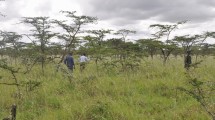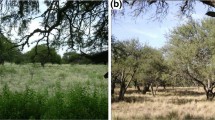Summary
In the Sonoran Desert, the sahuaro cactus (Carnegiea gigantea) is commonly associated with canopies of trees and shrubs: so-called nurse plants. Although mechanisms by which nurse plants facilitate sahuaro establishment have been studied, possible competitive interactions between sahuaro cacti and nurse plants have not been conclusively demonstrated. In this paper I show that the close proximity of sahuaros leads to a relative increase in stem die-back as well as greater mortality in a common nurse tree, the foothill paloverde (Cercidium microphyllum). This interaction appears to accelerate the local loss of individual nurse trees, resulting in a predictable pattern of species replacement.
Similar content being viewed by others
References
Barbour MG, Burk JH, Pitts WD (1980) Terrestrial plant ecology. Benjamin/Cummings Publ Co, Menlo Park, California, USA
Cannon WA (1911) The root habits of desert plants. Carnegie Institute Publ 131, Washington, DC, USA
Niering WA, Whittaker RH, Lowe CH (1963) The saguaro: a population in relation to environment. Science 142:15–23
Nobel PS (1980) Morphology, nurse plants, and minimum apical temperatures for young Carnegiea gigantea. Bot Gaz 141:188–191
Shreve F (1911) Establishment behavior of the palo verde. Plant World 14:289–296
Shreve F (1931) The cactus and its home. Williams and Wilkins, Baltimore USA
Steenberg WV, Lowe CH (1977) Ecology of the saguaro: II. Reproduction, germination, establishment, growth, and survival of the young plant. National Parks Service Scientific Monograph Series No 8. US Government Printing Office, Washington, DC, USA
Steenberg WV, Lowe CH (1983) Ecology of the saguaro: III. Growth and demography. National Parks Service Scientific Monograph Series No 17. US Government Printing Office, Washington, DC, USA
Turner RM (1963) Growth in four species of Sonoran Desert trees. Ecology 44:760–765
Turner RM, Alcorn SM, Olin G, Booth JA (1966) The influence of shade, soil, and water on saguaro seedling establishment. Bot Gaz 127:95–102
Vandermeer J (1980) Saguaros and nurse trees: A new hypothesis to account for population fluctuations. SW Nat 25:357–360
White PS (1979) Pattern, process and natural disturbance in vegetation. Bot Rev 45:229–299
Whittaker RH, Levin SA (1977) The role of mosaic phenomena in natural communities. Theor Pop Biol 12:117–139
Yeaton RI (1978) A cyclical relationship between Larrea tridentata and Opuntia leptocaulis in the northern Chihuahuan Desert. J Ecol 66:651–656
Yeaton RI, Travis J, Gilinsky E (1977) Competition and spacing in plant communities: The Arizona upland association. J Ecol 65:587–595
Author information
Authors and Affiliations
Rights and permissions
About this article
Cite this article
McAuliffe, J.R. Sahuaro-nurse tree associations in the Sonoran Desert: competitive effects of sahuaros. Oecologia 64, 319–321 (1984). https://doi.org/10.1007/BF00379128
Received:
Issue Date:
DOI: https://doi.org/10.1007/BF00379128




